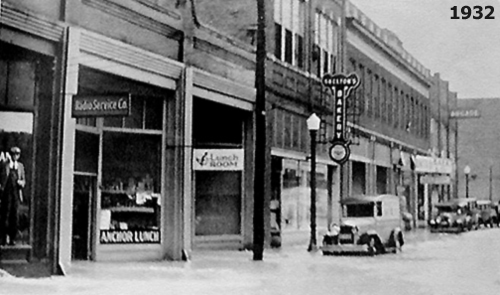Brush Creek is a stream of water that is very familiar to Johnson Citians, largely because of its long history of flooding. The name is reported to have originated with Abraham Jobe who owned land along the creek in what became the business section of the town. He once related that a heavy mass of red brush grew along the creek and obstructed the view except for those riding on horseback. Apparently, the name stuck.
A 1959 TVA publication concerning floods on Brush Creek in the vicinity of Johnson City stated that in 1908 there were 29 road and 14 railroad bridges that crossed the winding creek within an 8.75-mile span. The resulting 43 overpasses and nearby buildings with columns became hindrances to adequate water drainage from the area.

The 44-page report further noted that the greatest flood recorded since 1868 occurred on May 29, 1908. The second highest one happened on August 9, 1938. One million square feet of land in the downtown section was adversely affected by 3,300 feet of creek. Although there were no definite records of floods on Brush Creek prior to 1901, it is known that several major floods occurred in the business district. One of the best sources of knowledge on this subject comes from a diary kept by a local resident, Robert P. Fickle. His notes, while unofficial, shed added light on the city’s flood problems of yesteryear.
Mr. Fickle referred to “a great tide sometime in 1790.” He also mentioned 1817, 1835, 1847, 1848 and 1851 as years in which significant deluges occurred on streams in the upper East Tennessee region. On Sept. 15, 1861, he wrote, “A tide was made by a hard rain, which continued for four or five days with intermissions of 6, 12 and 24 hours. This tide was somewhat higher than the one seen in 1817.”
On Feb. 21, 1862, he noted, “It commenced raining steadily and rained without any intermission on the 21stand on during the night following until daylight on the 22nd. This tide was about two feet higher than the tide of 1861. This was a general tide (that extended) throughout the Southern Confederacy. Rain was general throughout the southern states.”
In March 1867, Mr. Fickle recorded that “The greatest tide yet in Holston River history was caused by the most unprecedented raining season known only to the oldest people. This was the great storm that caused flooding all over the eastern part of the Tennessee Valley and resulted in the highest floods ever known at Knoxville and Chattanooga. Great damage was done on the rivers and creeks. Bottoms on the river were damaged either by being washed into holes and gutters or covered by sand. Many mills were carried off, also houses, barns and stables thought to be out of reach of high water.”
In February 1875, the Fickle diary pointed out heavy rains that fell for several days that resulted in “raising the branches more than at any time since the great tide in 1867. Great damage was done to property along the water courses and a vast number of rails were carried off.”
While none of the flood comments specifically mentioned Brush Creek, there is no doubt that on most of these occasions rainfall over the Brush Creek watershed would have been sufficient to produce large floods along the creek. It is quite possible that the great storm of 1867 produced a flood in Brush Creek of greater volume and height than any that have occurred since.
Thanks to Mr. Fickle, we garner additional facts about the troublesome little creek that still occasionally wakes up from its restless slumber and climbs precariously out of its turbulent bed to the chagrin of nearby property owners.

Comments are closed.